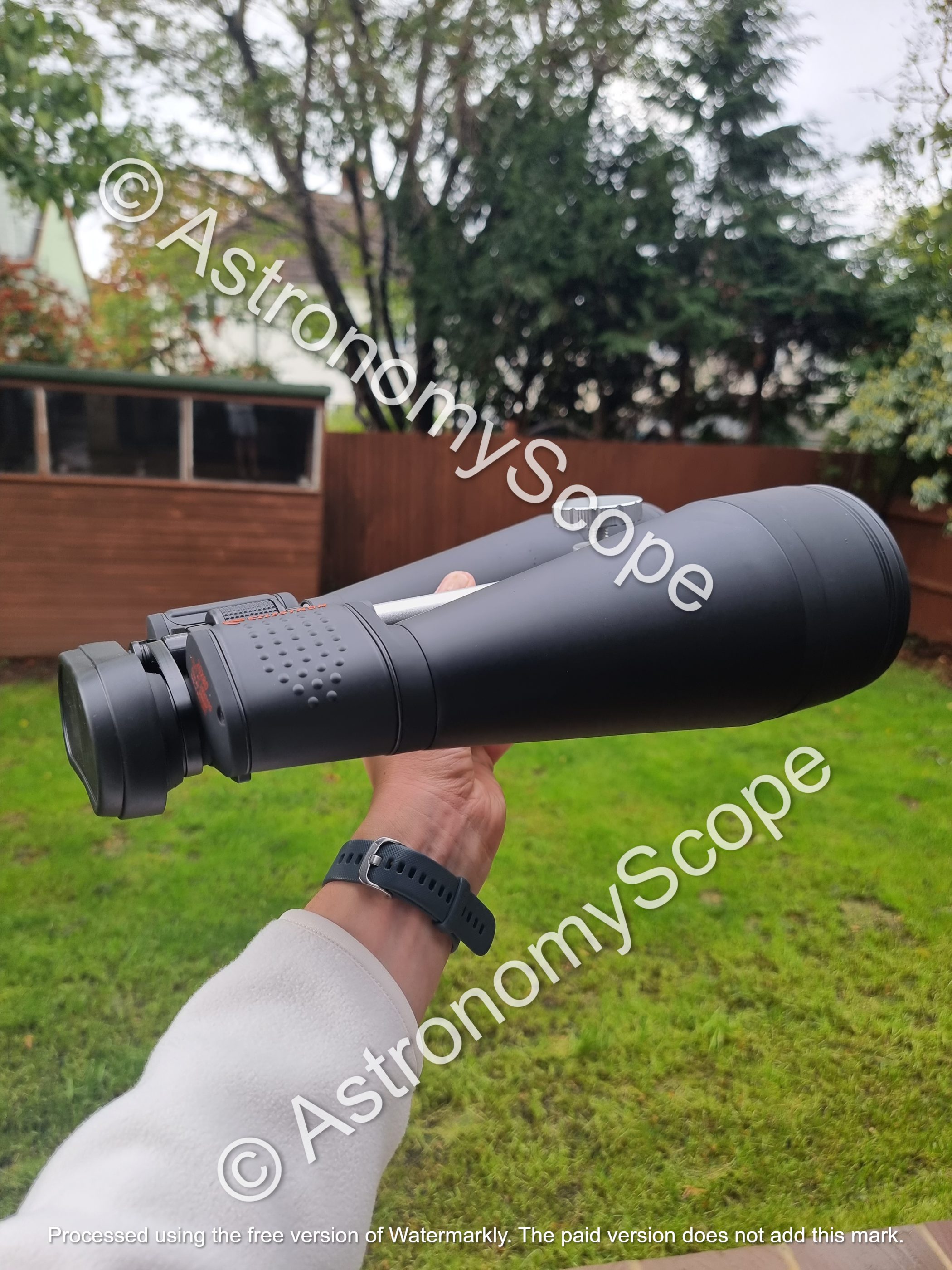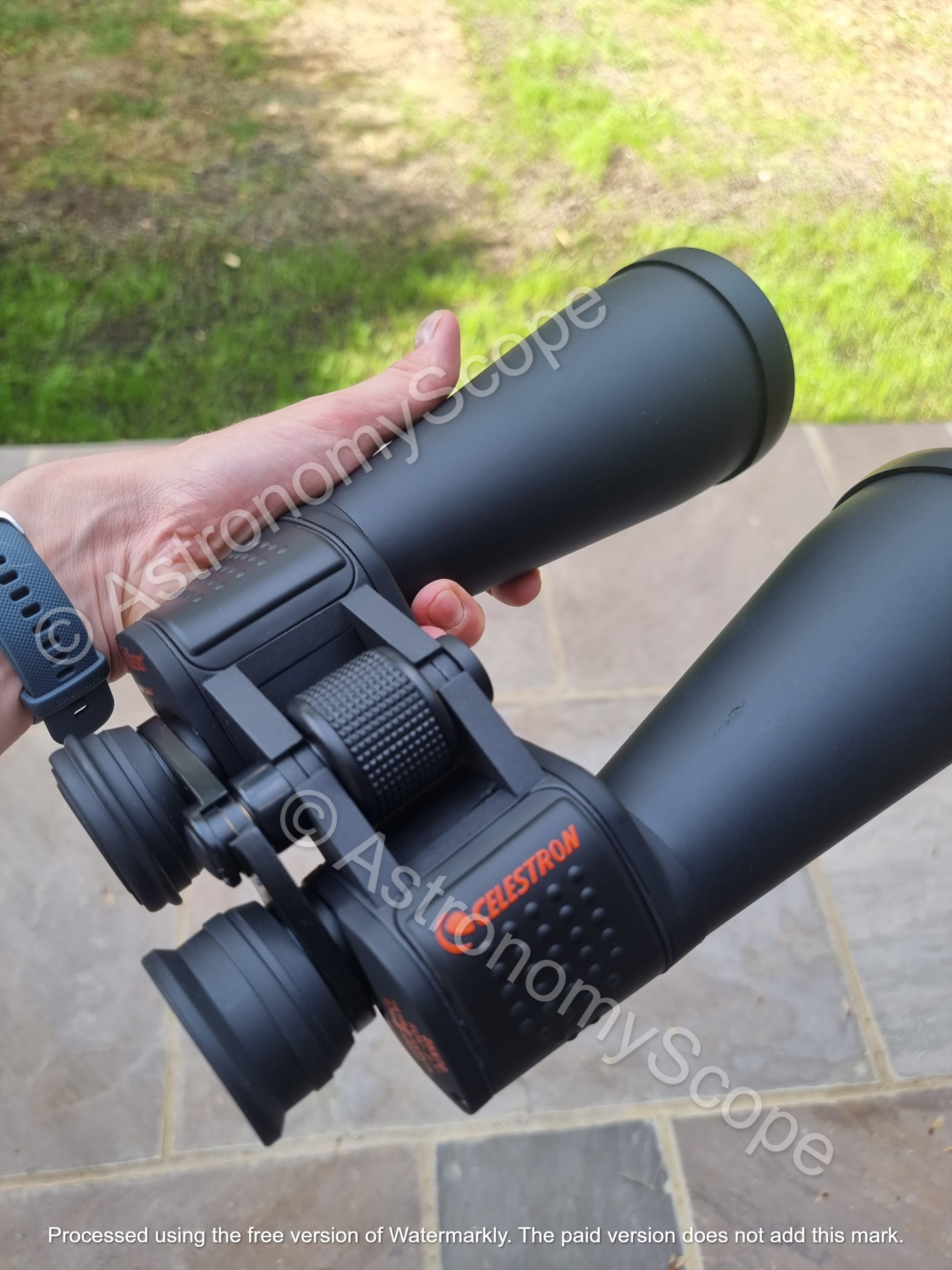Are you looking at Celestron SkyMaster Binoculars and are not sure which pair to get? Would you like to see a 20×80 vs 25×70 comparison and review of the spec so that you can make an informed decision? If so, this guide will help you do just that.
So, what is the difference between the Celestron Skymaster 20×80 vs 25×70? Both Celestron models are excellent and premium models of water-resistant binoculars that will provide you with clear, balanced views of the night sky. However, the 20x80s are considered optically superior to the 25×70 variant, with a greater Light Gathering Ability, Angle of View, Field of View, Focus Distance and Eye Relief.
I actually have bought, tested and played around with both of these models.
Here they are below, for reference:


Celestron SkyMaster 20×80 vs 25×70




Comparing The Spec
Now that you can see side by side the specification of both types, lets now quickly run through what it all means.
Prisms
Both pairs utilize Porro Prisms – an Optic Design and the way the binoculars handle light and project images.
Porro prisms are arranged in a certain way with the benefit of providing greater depths of field and wider field of views compared to other “Roof Prism” equivalents.
Magnification and Light Gathering Ability
Now onto the power and strength of each pair. The 20×80 and 25×70 is simply referring to the Magnification power and Lens Diameter of the Objective Lenses (front lenses) of each pair.
Both of these numbers are crucial to understand, because they indicate what you will be able to see and in what level of detail.
The Magnification is calculated in comparison to the naked eye (so 20/25x what your eyes can usually see).
The Diameter (80/70) is the measurement of the lenses at the front of the binoculars.
So, ’20×80′ binoculars give you 20 times the magnification of the object viewed by the naked eye, and achieves this with front lenses that are 80 millimeters in diameter.
25×70 on the other hand, will give you 25 times the magnification of the object viewed by the naked eye, and achieves this with front lenses that are 70 millimeters in diameter.
But what does this all mean?
At this stage, you might be thinking to opt for the pair with the highest magnification as this will enable you to see more. This is not the case!
The higher the magnification, relative to lens diameter, the dimmer the object will appear that you are viewing and the less you will ultimately see.
When it comes to astronomy, the larger the lenses you are using the better. This is because larger lenses collect more light and allow you to observe fainter objects in the sky. (This applies for Binoculars and Telescopes alike).
On a pair of binoculars, the front lenses are called ‘Objectives’, opposed to the smaller lenses that you look through (Eyepieces).
Both of these lenses work together to collect light and send it toward your eyes to present the image you are trying to observe.
Therefore it is critical you get the balance right between magnification and the lens diameter of the objective lenses.
Comparing the 20×80 and 25×70 SkyMasters, the former will able you to collect more light and display images with more detail than the latter. Although the 25x70s can ‘zoom in’ slightly further. Hopefully by now you realize that being able to ‘zoom’ is not as important as the ability for binoculars to gather light. Therefore the 20x80s produce better images.
Angle of View
Angle of View is simply, the coverage of the sky you get when looking through the binoculars.
It is basically the true angle that can be seen when looking through the optics. It is measured in °.
As you will see from the specification table above, the 20×80 SkyMasters give you a greater Angle of View (3.2°) compared to that of the 27×70 SkyMasters (2.7°)
What this all means is that you will be able to observe more of the Night Sky (a larger area) at any one time with the 20x80s.
Field of View
The Field of View dictates the width of the image that you see. It is far more closely tied to the magnification.
Typically, a larger field of view is considered better, especially in situations where objects are moving (like some objects in the night sky).
This is because a larger field of view gives more room for error when observing the sky, ensuring the objects stay in your view for longer.
Its important to note that field of view usually decreases with higher magnification. This is why astronomers typically prefer higher fields of view, less magnification (e.g. the 20x80s are preferred).
The 20×80 SkyMasters have a superior field of view to the 25x70s.
Minimum Focus Distance
The Minimum Focus Distance simply means the shortest distance at which the lenses can focus.
In other words, it dictates your ability to look at the finer details of the planets, stars and other objects in the night sky.
Normally, as magnification is increased, the minimum focus distance also increases.
However, when we look at the 20x80s and the 25x70s you will notice that this isn’t the case.
This is because the 25x70s provide a higher magnification than the 20x80s, but the 20x80s provide a great minimum focus distance.
What this all means is that the 20x80s provide you with the ability to focus more closely.
Exit Pupil Diameter
The Exit Pupil Diameter is the measurement of the width of of light that comes through the eyepiece on your binoculars.
It is primarily measured in millimeters, by dividing the size of the objective lens by the magnification (80/20=4mm, 70/25=2.8 mm)
Having a large exit pupil is beneficial when observing in low light conditions, especially at night, as images appear brighter.
The Exit Pupil is calculated against the dilation of an eye’s pupil once it has become dark-adapted, and for the most part, this number falls between 5 mm and 9 mm (the maximum dilation of a human eye).
Its important to note that having a larger exit pupil larger than the dilation of your eye is wasting light.
This is because the light can only fall onto your iris, but cannot penetrate into your eye.
Thankfully, both the 20×80 or 20×80 models provide Exit Pupil Diameters well within range.
The 20×80 pair essentially provide more light into your eye and will ultimately enable you to see more (especially in dark conditions)
Eye Relief
Eye relief is pretty simple. Its the distance from your eyes and the eyepieces when the entire field of view is comfortably observed. It is measured in millimeters.
It is basically looking at the spacing from the eyepiece lens to the area behind the eyepiece where light is focused and images are formed.
This will also be the optimal place for your eye to observe the full field of view that the binoculars can provide.
At minimum, you are going to want your Eye Relief to be at its lowest,10 mm. The Higher you go, the better the comfort (especially so if you wear glasses).
The 20x80s provide a higher eye relief than the 25x70s and are therefore more comfortable.
Focus Type
All binoculars in the SkyMaster range utilize a Center Focus Type.
This provides you with a central single wheel that you can use to focus in on objects. Having this wheel ensures that you can focus on objects at a distance of your preference – both close and far away.
This makes them more versatile and adaptable than other types.
Weight
Its pretty self explanatory, but the weight is how heavy the binoculars are to hold.
This is a factor you should consider depending on the use of your binoculars; will you be using them for longer periods, what are your preferences and what are you able to lift.
The 20×80 are slightly more heavy than the 25x70s, by approximately 2.5 lbs. Only you will be able to decide if this difference is significant to you.
Both pairs are Tripod Adaptable, meaning that you can easily attach them to a Tripod (three-legged base).
This is ideal if you want to observe for long periods of time, and want to more easily and steadily focus your binoculars.
Verdict and Final Words
In a direct SkyMaster 20×80 vs 25×70 comparison, the 20×80 SkyMasters have overall better optics and power.
I’ve reviewed a lot of specification here, and these were the things that I personally considered before I invested in a pair of binoculars for Astronomy.
I decided to go for the 20x80s with all the above factors considered.
However, depending on your budget/ your preference for a lighter pair, the 25x70s SkyMasters may be better for you. Failing that always consider a Tripod.
Ultimately, both pairs of binoculars have solid and positive reviews and recommendations on Amazon.
Whether its the 20x80s or the 25x70s, the Celestron SkyMasters will provide you with great, crisp and clear views of the night sky.
View the 20×80 SkyMaster Reviews on Amazon | View the 25×70 SkyMaster Reviews on Amazon
Or want to learn more about these binoculars?
Read my independent reviews:
Related Guides
- Celestron SkyMaster 12×60 vs 15×70
- Celestron Skymaster 15×70 vs 25×70
- Celestron SkyMaster 12×60 Review
- Celestron SkyMaster 25×100 Review
- Celestron Skymaster Pro 20×80 Review

Hey, my name is Jeremy. I’m a passionate and seasoned astronomer who loves nothing more than observing the night sky. I also love researching, learning, and writing all things Space and the Universe. I created Astronomy Scope to share my knowledge, experience, suggestions, and recommendations of what I have learned along the way while helping anyone to get into and maximize their enjoyment of the hobby.

